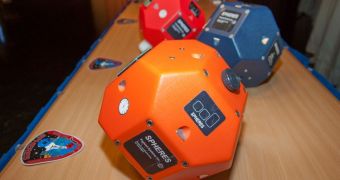Entirely self-contained robotic units called SPHERES will return to the International Space Station soon, under a new Zero-Robotics competition hosted by the European Space Agency (ESA). Each Member State in the organization will participate with a maximum of 25 student teams.
The miniature satellites were activated aboard the ISS last winter, when ESA astronaut Andres Kuipers kept a close eye on the project, and helped officials evaluate the performances of each of the 25 teams that took part in the first iteration of the competition.
Now, significantly more teams will participate. Each of these groups will have to control the small robots, make them spin, hover, rotate and perform a variety of other tasks. A number of mentors will assist each of the teams in this effort.
SPHERES is an acronym that stands for Synchronised Position Hold, Engage, Reorient, Experimental Satellites. Each unit can fly inside the ISS without posing any type of threat to astronauts or equipment.
They contain onboard power, propulsion, computing and navigational software, and are entirely self-sufficient as long as batteries last. The original design for these satellites was augmented with a Samsung Nexus S™ smartphone, running the open-source Android™ platform developed by Google.
The handset received only minor modifications before being attached to SPHERES. By adding the Samsung Nexus S™, NASA turned the free-flying robots into so-called Smart SPHERES.
Each of the small robots now contains a small, energy-efficient computer within each unit, which allows them to compile basic calculations of data provided by their cameras and sensors.
“All tournaments are free of charge and open to upper secondary schools. Teachers and professionals are encouraged to work on the challenge together with the school teams,” ESA announces in a press release.
“To compete for the finest moves, mentors must register their teams on the Zero-Robotics website for the European 2012 competition before September. Please create an account first, then register for the European tournament,” the statement adds.
SPHERES have been developed by the American space agency, but ESA has been allowed to use them for this competition. Since last winter, the robots have been in storage aboard the ISS.
In time, NASA plans to expand the functionality of these robots, so that they can perform more complex tasks, and even fly outside the station. The small satellites would help Mission Control monitor astronauts and their performances from previously impossible to attain vantage points.
“The tests that we are conducting with Smart SPHERES will help NASA make better use of robots as assistants to and versatile support for human explorers – in Earth orbit or on long missions to other worlds and new destinations,” says Terry Fong, a NASA official at the Ames Research Center.

 14 DAY TRIAL //
14 DAY TRIAL //